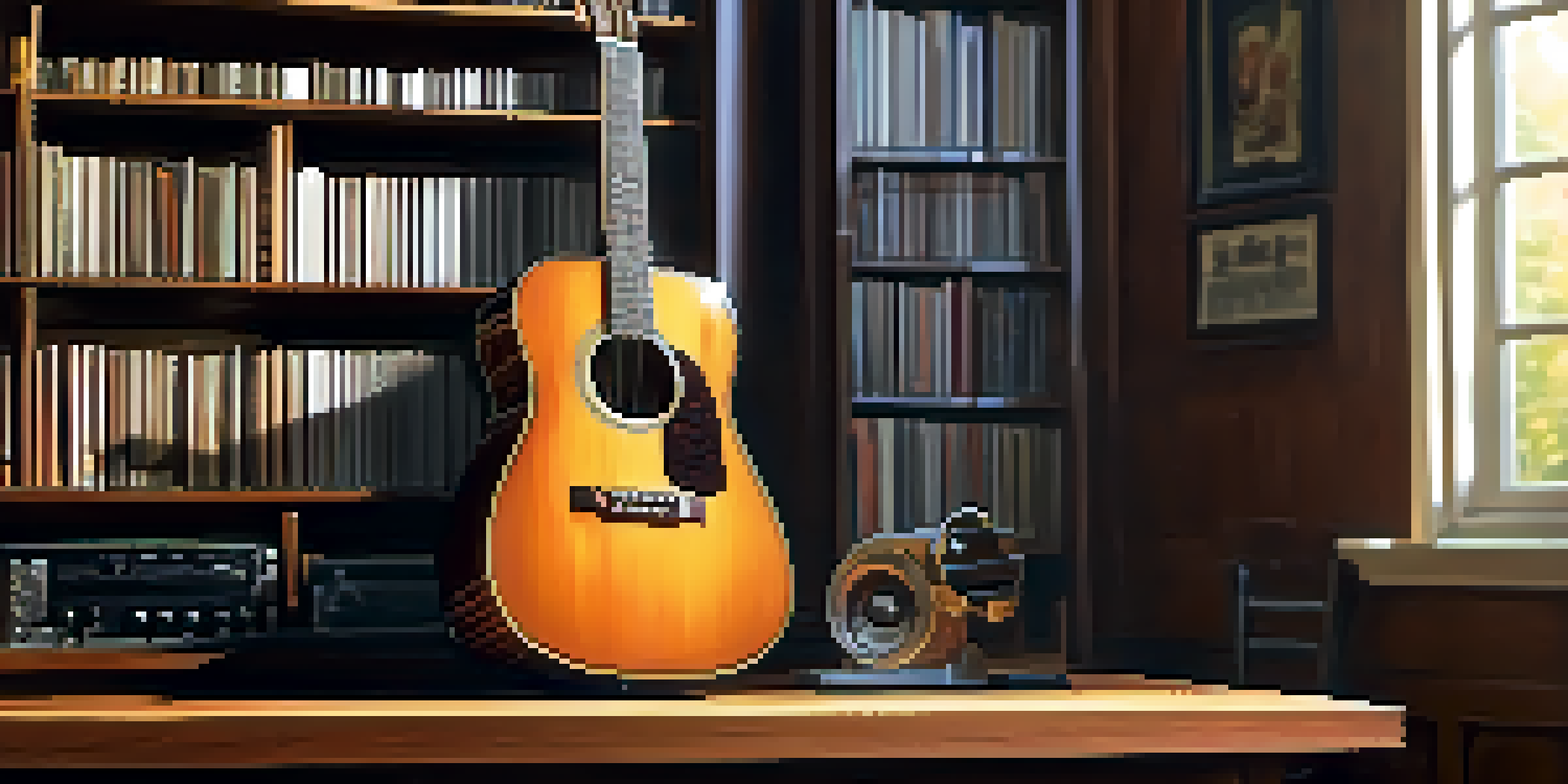Understanding Different Guitar Finishes: Care Tips and Tricks

The Importance of Guitar Finishes and Their Functions
Guitar finishes are more than just aesthetics; they protect the wood from moisture, dirt, and wear. They play a crucial role in determining the instrument's sound, feel, and overall durability. Different finishes can influence how vibrations travel through the wood, affecting tone and resonance.
The guitar is a wonderful instrument, but it can be easily damaged if not cared for properly.
For example, a nitrocellulose finish is known for its thin layer that allows the wood to breathe, often resulting in a warmer sound. Conversely, polyurethane finishes are thicker and more durable, providing excellent protection but may dampen some tonal qualities. Understanding these differences can help you choose a guitar that suits your preferences.
Ultimately, the finish you choose or maintain can significantly impact your playing experience and the guitar's longevity, so it's essential to consider it with care.
Common Types of Guitar Finishes: A Quick Overview
There are several popular types of finishes used on guitars, each with its unique properties. Nitrocellulose lacquer is favored for its vintage appeal and sound enhancement, while polyurethane offers durability and ease of maintenance. Then there's oil finish, which provides a natural feel and enhances the grain of the wood.

Shellac, a more traditional option, gives a warm glow but requires more maintenance to keep it looking fresh. Understanding these finishes can help you appreciate your instrument's craftsmanship and how it may affect your playing style.
Guitar Finishes Affect Sound and Care
The type of finish on a guitar not only impacts its appearance but also influences sound quality and maintenance needs.
Each finish comes with its own set of care instructions, so knowing what type you have can save you time and effort in maintenance.
How to Identify Your Guitar's Finish Type
Identifying your guitar's finish can be as simple as inspecting its surface and feel. A nitrocellulose finish feels smooth and may appear thin, while a polyurethane finish often has a glossy, thick appearance. If you're unsure, a quick test with a soft cloth can help; nitro finishes will typically react to solvents like alcohol, while poly finishes won't.
Every guitar is a story, and every finish is a chapter in that story.
Another method involves looking for signs of wear; nitro finishes age beautifully and develop a patina, whereas poly finishes tend to show fewer signs of aging. If you’re still in doubt, consulting your guitar's manual or reaching out to the manufacturer can provide clarity.
Knowing your finish type not only helps in maintenance but also lets you understand how to treat your instrument with the care it deserves.
General Care Tips for All Guitar Finishes
Regardless of the finish type, there are universal care tips every guitar owner should follow. Keep your guitar away from extreme temperatures and humidity, as these factors can warp the wood and damage the finish. Regularly wipe down your instrument with a soft microfiber cloth to remove oils and dirt that may accumulate from playing.
Be mindful of where you store your guitar; a hard case is often the best option to protect it from dust and accidental bumps. Additionally, avoid using harsh chemicals or cleaners that can strip away the finish and harm the wood underneath.
Humidity is Crucial for Guitar Health
Maintaining proper humidity levels is essential for preserving your guitar's wood and finish, preventing warping and cracks.
These simple steps can go a long way in prolonging the beauty and sound of your guitar.
Specific Care Tips for Nitrocellulose Finishes
Nitrocellulose finishes require a bit more attention due to their delicate nature. To keep them in top shape, use a cleaner specifically designed for nitro finishes, as regular guitar sprays may contain chemicals that can damage the surface. Avoid leaving your guitar exposed to sunlight for long periods, as UV rays can cause fading and wear.
When it comes to polishing, less is more with nitro finishes. A light polish every few months can help maintain its shine without risking buildup. Regularly check for cracks or chips, as these can lead to larger issues if not addressed promptly.
Taking these precautions can ensure your nitro-finished guitar remains as stunning as the day you got it.
Care Tips for Polyurethane Finishes
Polyurethane finishes are more forgiving than nitro, but they still need proper care to maintain their appearance. Regularly clean the surface with a damp cloth to remove dust and grime, and dry it immediately to prevent water spots. Since this finish is more resilient, you can use a mild soap solution for deeper cleaning when necessary.
While polyurethane is less prone to damage, it can still show scratches over time. For minor scratches, a polishing compound can help restore the shine without harming the finish. It’s also wise to avoid using abrasive materials or cleaners that can dull the surface.
Different Finishes Require Unique Care
Each guitar finish, whether nitrocellulose or polyurethane, has specific care instructions to ensure longevity and performance.
By treating your polyurethane-finished guitar with care, you'll ensure it looks great and sounds even better.
The Role of Humidity in Guitar Care
Humidity plays a significant role in the health of your guitar, regardless of its finish. Ideal humidity levels for guitars typically range from 40% to 60%. Too much moisture can lead to warping, while too little can cause the wood to dry out, resulting in cracks and other damage.
Using a hygrometer to monitor the humidity in your environment can be a game changer for guitar care. During dry seasons, consider using a guitar humidifier to maintain optimal moisture levels, especially if you own an acoustic guitar. Conversely, ensure your guitar is not exposed to overly humid conditions, as this can ruin finishes and affect sound quality.

Keeping a close eye on humidity can significantly extend your guitar's lifespan and preserve its playability.